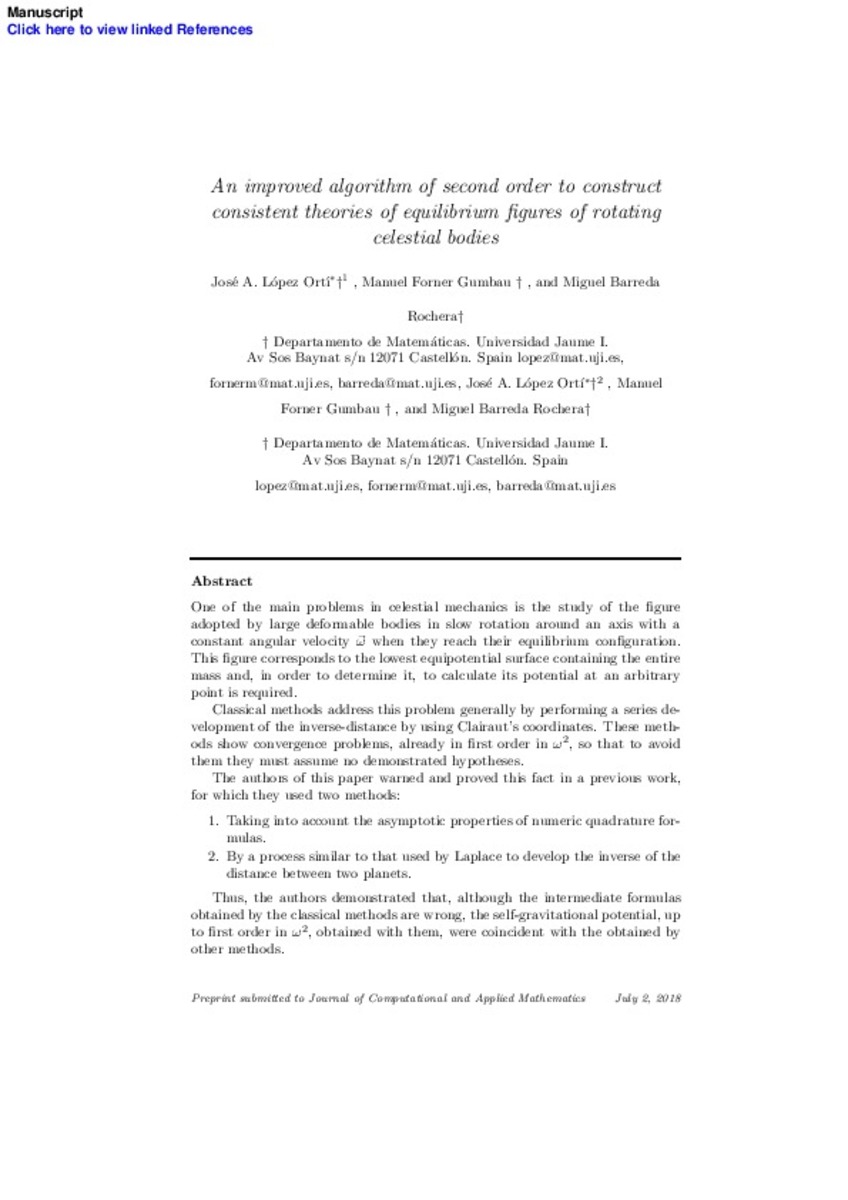Mostrar el registro sencillo del ítem
An improved algorithm of second order to construct consistent theories of equilibrium figures of rotating celestial bodies
| dc.contributor.author | López Ortí, José Antonio | |
| dc.contributor.author | Forner Gumbau, Manuel | |
| dc.contributor.author | Barreda Rochera, Miguel | |
| dc.date.accessioned | 2018-11-05T11:42:51Z | |
| dc.date.available | 2018-11-05T11:42:51Z | |
| dc.date.issued | 2018-08 | |
| dc.identifier.citation | ORTÍ, José A. López; GUMBAU, Manuel Forner; ROCHERA, Miguel Barreda. An improved algorithm of second order to construct consistent theories of equilibrium figures of rotating celestial bodies. Journal of Computational and Applied Mathematics, 2018. | ca_CA |
| dc.identifier.uri | http://hdl.handle.net/10234/177209 | |
| dc.description.abstract | One of the main problems in celestial mechanics is the study of the figure adopted by large deformable bodies in slow rotation around an axis with a constant angular velocity W when they reach their equilibrium configuration. This figure corresponds to the lowest equipotential surface containing the entire mass and, in order to determine it, calculating its potential at an arbitrary point is required. Classical methods address this problem generally by performing a series development of the inverse-distance by using Clairaut’s coordinates. These methods show convergence problems, already in first order in W2, so that to avoid them they must assume no demonstrated hypotheses. The authors of this paper warned and proved this fact in a previous work, for which they used two methods: 1. Taking into account the asymptotic properties of numeric quadrature formulas. 2. By a process similar to that used by Laplace to develop the inverse of the distance between two planets. Thus, the authors demonstrated that, although the intermediate formulas obtained by the classical methods are wrong, the self-gravitational potential, up to first order in w2, obtained with them, were coincident with those obtained by other methods. Now, in this paper an extension up to second order in w2 of the first method mentioned above is proposed. It shows rigorously that up to second order in , the intermediate formulas obtained by the classical methods are erroneous. In addition, the correct developments, up to second order in W2, of those intermediate formulas are obtained. In spite of these discrepancies, the auto-gravitational potential, up to second order in , obtained by the classical methods and the one obtained in this work are coincident, consequently it is proved that the classical theory is correct until second order in W2. | ca_CA |
| dc.format.extent | 18 p. | ca_CA |
| dc.format.mimetype | application/pdf | ca_CA |
| dc.language.iso | eng | ca_CA |
| dc.publisher | Elsevier | ca_CA |
| dc.rights | © 2018 Elsevier B.V. All rights reserved. | ca_CA |
| dc.rights.uri | http://rightsstatements.org/vocab/InC/1.0/ | * |
| dc.subject | computational algebra | ca_CA |
| dc.subject | perturbation theory | ca_CA |
| dc.subject | close binary systems | ca_CA |
| dc.subject | potential theory | ca_CA |
| dc.subject | spherical harmonics | ca_CA |
| dc.title | An improved algorithm of second order to construct consistent theories of equilibrium figures of rotating celestial bodies | ca_CA |
| dc.type | info:eu-repo/semantics/book | ca_CA |
| dc.identifier.doi | https://doi.org/10.1016/j.cam.2018.08.028 | |
| dc.rights.accessRights | info:eu-repo/semantics/openAccess | ca_CA |
| dc.relation.publisherVersion | https://www.sciencedirect.com/science/article/pii/S0377042718305156 | ca_CA |
| dc.type.version | info:eu-repo/semantics/submittedVersion | ca_CA |
Ficheros en el ítem
Este ítem aparece en la(s) siguiente(s) colección(ones)
-
MAT_Articles [749]
Articles de publicacions periòdiques







